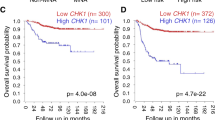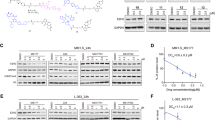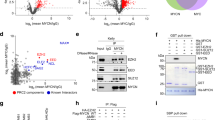Abstract
MYC-driven medulloblastomas (MB) are highly aggressive pediatric brain tumors with poor outcomes, and effective therapies remain limited despite intensive multimodal treatments. Targeting MYC directly is challenging, but exploiting MYC-mediated synthetic lethality holds promise. In this study, we investigated the combined effects of EZH2 and PARP inhibitors in MYC-high medulloblastoma and demonstrated that EZH2 inhibition significantly increased the sensitivity of MYC-high MB tumor cells to PARP inhibitors. This effect occurs through the upregulation of NUPR1, which promotes error-prone non-homologous end-joining (NHEJ) DNA repair by facilitating the recruitment of the XRCC4-LIG4 complex to DNA damage sites. This amplification of error-prone NHEJ DNA repair leads to genetic instability and eventual cell death in cells treated with the PARP inhibitor. The synergistic effect of EZH2 and PARP inhibitors was further validated in both in vitro and in vivo MB models without observed toxicity. These findings reveal a novel therapeutic strategy for MYC-high MB by co-targeting EZH2 and PARP, suggesting that this combination could potentially overcome the clinical challenges associated with this aggressive tumor subtype and warrants further investigation in clinical trials.

This is a preview of subscription content, access via your institution
Access options
Subscribe to this journal
Receive 50 print issues and online access
$259.00 per year
only $5.18 per issue
Buy this article
- Purchase on SpringerLink
- Instant access to full article PDF
Prices may be subject to local taxes which are calculated during checkout






Similar content being viewed by others
Data availability
The differentially expressed genes (DEGs) from the RNA-seq reported in this paper are provided in the supplementary files. The NCI-60 transcriptome database, utilized for analyzing gene expression correlations, was sourced from CellMinerCDB (https://discover.nci.nih.gov/rsconnect/cellminercdb/).
References
Juraschka K, Taylor MD. Medulloblastoma in the age of molecular subgroups: a review. J Neurosurg Pediatr. 2019;24:353–63.
Northcott PA, Dubuc AM, Pfister S, Taylor MD. Molecular subgroups of medulloblastoma. Expert Rev Neurother. 2012;12:871–84.
Wang J, Garancher A, Ramaswamy V, Wechsler-Reya RJ. Medulloblastoma: from molecular subgroups to molecular targeted therapies. Annu Rev Neurosci. 2018;41:207–32.
Holgado BL, Guerreiro Stucklin A, Garzia L, Daniels C, Taylor MD. Tailoring medulloblastoma treatment through genomics: making a change, one subgroup at a time. Annu Rev Genomics Hum Genet. 2017;18:143–66.
Han J, Yu M, Bai Y, Yu J, Jin F, Li C, et al. Elevated CXorf67 expression in PFA ependymomas suppresses DNA repair and sensitizes to PARP inhibitors. Cancer Cell. 2020;38:844–856.e847.
Han J, Song X, Liu Y, Li L. Research progress on the function and mechanism of CXorf67 in PFA ependymoma. Chin Sci Bull. 2022;67:1–8.
van Vuurden DG, Hulleman E, Meijer OL, Wedekind LE, Kool M, Witt H, et al. PARP inhibition sensitizes childhood high grade glioma, medulloblastoma and ependymoma to radiation. Oncotarget. 2011;2:984–96.
Hoglund A, Stromvall K, Li Y, Forshell LP, Nilsson JA. Chk2 deficiency in Myc overexpressing lymphoma cells elicits a synergistic lethal response in combination with PARP inhibition. Cell Cycle. 2011;10:3598–607.
Yi J, Liu C, Tao Z, Wang M, Jia Y, Sang X, et al. MYC status as a determinant of synergistic response to Olaparib and Palbociclib in ovarian cancer. EBioMedicine. 2019;43:225–37.
Cao R, Zhang Y. The functions of E(Z)/EZH2-mediated methylation of lysine 27 in histone H3. Curr Opin Genet Dev. 2004;14:155–64.
Koh CM, Iwata T, Zheng Q, Bethel C, Yegnasubramanian S, De Marzo AM. Myc enforces overexpression of EZH2 in early prostatic neoplasia via transcriptional and post-transcriptional mechanisms. Oncotarget. 2011;2:669–83.
Nie Z, Guo C, Das SK, Chow CC, Batchelor E, Simons SSJ, et al. Dissecting transcriptional amplification by MYC. Elife 2020;9:e52483.
Natsumeda M, Liu Y, Nakata S, Miyahara H, Hanaford A, Ahsan S, et al. Inhibition of enhancer of zest homologue 2 is a potential therapeutic target for high-MYC medulloblastoma. Neuropathology. 2019;39:71–77.
Zhang X, Huo X, Guo H, Xue L. Combined inhibition of PARP and EZH2 for cancer treatment: current status, opportunities, and challenges. Front Pharm. 2022;13:965244.
Karakashev S, Fukumoto T, Zhao B, Lin J, Wu S, Fatkhutdinov N, et al. EZH2 Inhibition Sensitizes CARM1-High, Homologous Recombination Proficient Ovarian Cancers to PARP Inhibition. Cancer Cell. 2020;37:157–167.e156.
Ianevski A, Giri AK, Aittokallio T. SynergyFinder 3.0: an interactive analysis and consensus interpretation of multi-drug synergies across multiple samples. Nucleic Acids Res. 2022;50:W739–W743.
Gironella M, Malicet C, Cano C, Sandi MJ, Hamidi T, Tauil RM, et al. p8/nupr1 regulates DNA-repair activity after double-strand gamma irradiation-induced DNA damage. J Cell Physiol. 2009;221:594–602.
Sander S, Bullinger L, Klapproth K, Fiedler K, Kestler HA, Barth TF, et al. MYC stimulates EZH2 expression by repression of its negative regulator miR-26a. Blood. 2008;112:4202–12.
Neves Filho EH, Hirth CG, Frederico IA, Burbano RM, Carneiro T, Rabenhorst SH. EZH2 expression is dependent on MYC and TP53 regulation in diffuse large B-cell lymphoma. APMIS. 2020;128:308–15.
Petralia F, Tignor N, Reva B, Koptyra M, Chowdhury S, Rykunov D, et al. Integrated proteogenomic characterization across major histological types of pediatric brain cancer. Cell. 2020;183:1962–1985.e1931.
Rajapakse VN, Luna A, Yamade M, Loman L, Varma S, Sunshine M, et al. CellMinerCDB for integrative cross-database genomics and pharmacogenomics analyses of cancer cell lines. iScience. 2018;10:247–64.
Gardner EE, Lok BH, Schneeberger VE, Desmeules P, Miles LA, Arnold PK, et al. Chemosensitive relapse in small cell lung cancer proceeds through an EZH2-SLFN11 axis. Cancer Cell. 2017;31:286–99.
Ceccaldi R, Rondinelli B, D’Andrea AD. Repair pathway choices and consequences at the double-strand break. Trends Cell Biol. 2016;26:52–64.
Scully R, Panday A, Elango R, Willis NA. DNA double-strand break repair-pathway choice in somatic mammalian cells. Nat Rev Mol Cell Biol. 2019;20:698–714.
Lan W, Santofimia-Castano P, Swayden M, Xia Y, Zhou Z, Audebert S, et al. ZZW-115-dependent inhibition of NUPR1 nuclear translocation sensitizes cancer cells to genotoxic agents. JCI Insight. 2020;5:e138117.
Ahnesorg P, Smith P, Jackson SP. XLF interacts with the XRCC4-DNA ligase IV complex to promote DNA nonhomologous end-joining. Cell. 2006;124:301–13.
Moon JJ, Lu A, Moon C. Role of genomic instability in human carcinogenesis. Exp Biol Med. 2019;244:227–40.
Whitfield JR, Beaulieu ME, Soucek L. Strategies to inhibit Myc and their clinical applicability. Front Cell Dev Biol. 2017;5:10.
Llombart V, Mansour MR. Therapeutic targeting of “undruggable” MYC. EBioMedicine. 2022;75:103756.
Kim D, Nam HJ. PARP inhibitors: clinical limitations and recent attempts to overcome them. Int J Mol Sci. 2022;23:8412.
Ning JF, Wakimoto H. Therapeutic application of PARP inhibitors in neuro-oncology. Trends Cancer. 2020;6:147–59.
Bhamidipati D, Haro-Silerio JI, Yap TA, Ngoi N. PARP inhibitors: enhancing efficacy through rational combinations. Br J Cancer. 2023;129:904–16.
Han J, Yu J, Yu M, Liu Y, Song X, Li H, et al. Synergistic effect of poly (ADP-ribose) polymerase (PARP) inhibitor with chemotherapy on CXorf67-elevated posterior fossa group A ependymoma. Chin Med J. 2024;137:1–3.
Colicchia V, Petroni M, Guarguaglini G, Sardina F, Sahun-Roncero M, Carbonari M, et al. PARP inhibitors enhance replication stress and cause mitotic catastrophe in MYCN-dependent neuroblastoma. Oncogene. 2017;36:4682–91.
Qi L, Lindsay H, Kogiso M, Du Y, Braun FK, Zhang H, et al. Evaluation of an EZH2 inhibitor in patient-derived orthotopic xenograft models of pediatric brain tumors alone and in combination with chemo- and radiation therapies. Lab Invest. 2022;102:185–93.
Dickson KA, Xie T, Evenhuis C, Ma Y, Marsh DJ. PARP inhibitors display differential efficacy in models of BRCA mutant high-grade serous ovarian cancer. Int J Mol Sci. 2021;22:8506.
Martin TA, Li AX, Sanders AJ, Ye L, Frewer K, Hargest R, et al. NUPR1 and its potential role in cancer and pathological conditions. Int J Oncol. 2021;58:21.
Aguado-Llera D, Hamidi T, Domenech R, Pantoja-Uceda D, Gironella M, Santoro J, et al. Deciphering the binding between Nupr1 and MSL1 and their DNA-repairing activity. PLoS ONE. 2013;8:e78101.
Leibowitz ML, Zhang CZ, Pellman D. Chromothripsis: a new mechanism for rapid karyotype evolution. Annu Rev Genet. 2015;49:183–211.
Sishc BJ, Davis AJ. The role of the core non-homologous end joining factors in carcinogenesis and cancer. Cancers. 2017;9:81.
Drean A, Lord CJ, Ashworth A. PARP inhibitor combination therapy. Crit Rev Oncol Hematol. 2016;108:73–85.
Zeng J, Han J, Liu Z, Yu M, Li H, Yu J. Pentagalloylglucose disrupts the PALB2-BRCA2 interaction and potentiates tumor sensitivity to PARP inhibitor and radiotherapy. Cancer Lett. 2022;546:215851.
Louis DN, Perry A, Reifenberger G, von Deimling A, Figarella-Branger D, Cavenee WK, et al. The 2016 World Health Organization Classification of Tumors of the Central Nervous System: a summary. Acta Neuropathol. 2016;131:803–20.
Acknowledgements
We would like to thank Yachao Liu from the ShanghaiTech University for his assistance with the reagents and plasmids essential for generating our stable cell lines.
Funding
This research was supported by the National Natural Science Foundation of China (82103123), the China Postdoctoral Science Foundation (2021M703208), and the Cyrus Tang Foundation (No. ZSBK0070).
Author information
Authors and Affiliations
Contributions
Jianzhong Yu: writing – original draft, methodology, investigation, formal analysis, data curation. Jichang Han: writing – original draft, formal analysis, visualization, project administration, funding acquisition, conceptualization. Meng Yu: methodology, investigation, formal analysis. Huanwen Rui: methodology, validation. An Sun: resources, supervision. Hao Li: writing – review & editing, funding acquisition, conceptualization, supervision.
Corresponding authors
Ethics declarations
Competing interests
The authors declare no competing interests.
Ethics approval and consent to participate
MB tissue specimens were obtained from the Children’s Hospital of Fudan University after approval by the ethics review board of the hospital. All patients were informed, and consent was obtained. All animal experiments were approved by the Institutional Animal Care and Use Committee (IACUC) of the Children’s Hospital of Fudan University.
Consent for publication
The authors consent to publish the paper.
Additional information
Publisher’s note Springer Nature remains neutral with regard to jurisdictional claims in published maps and institutional affiliations.
Supplementary information
Rights and permissions
Springer Nature or its licensor (e.g. a society or other partner) holds exclusive rights to this article under a publishing agreement with the author(s) or other rightsholder(s); author self-archiving of the accepted manuscript version of this article is solely governed by the terms of such publishing agreement and applicable law.
About this article
Cite this article
Yu, J., Han, J., Yu, M. et al. EZH2 inhibition sensitizes MYC-high medulloblastoma cancers to PARP inhibition by regulating NUPR1-mediated DNA repair. Oncogene 44, 391–405 (2025). https://doi.org/10.1038/s41388-024-03232-9
Received:
Revised:
Accepted:
Published:
Issue date:
DOI: https://doi.org/10.1038/s41388-024-03232-9
This article is cited by
-
Chitosan-Functionalization Graphene Oxide for Immobilizing Gold Nanoparticles: Application of Its Catalytic Performance in the Reduction of Methylene Blue and Methyl Orange and Investigation of Its Anti-lung Cancer Effects
Journal of Inorganic and Organometallic Polymers and Materials (2025)
-
Ultrasound-assisted biosynthesis of gelatin-gold nanocomposite: investigation of its antioxidant activity and its performance as anti-endometrial cancer in vitro
Transition Metal Chemistry (2025)
-
Effect of Zr4+ dopants on micro-structural and antibacterial characteristics of CuFe2O4 nanoparticles produced via sol-gel auto combustion
Journal of Sol-Gel Science and Technology (2025)
-
Crystal structural characteristics and optical and electrical properties of Bi-doped (Ba0.8Sr0.2)(Ti0.85Zr0.15)O3 perovskite ceramics
Journal of Materials Science: Materials in Electronics (2025)
-
Green Synthesis of Nickel Oxide Nanoparticles Using Pistacia atlantica Leaves Extract: Characterization, Catalytic Activity for Synthesis of Pyrazolo[3,4-b]pyridines, and Investigation of Its Anti-hepatic Cancer Effects
Journal of Inorganic and Organometallic Polymers and Materials (2025)



